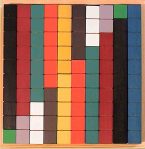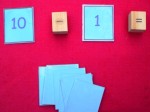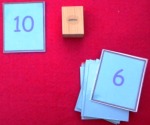This blog follows on from the blog dated 30/10/10 using Stern’s structured concrete apparatus to enable children to master the basic facts to 10 and less than 10.
The ideas and games set out in part 2, assume that children are already demonstrating levels of accuracy with number bonds to 10 using the Stern blocks and activities from memory. What we need to do now is make the transition away from concrete support to working with numerals. Our memory games aim to encourage this practice from memory and speed up the process of recall. Each game provides a single focus, and can be repeated as often as required.
Practice with combinations to 10
Objective: reinforcing combinations – 1 and 9, 2 and 8, 3 and 7 and so forth
Materials: two sets of numeral cards 0 – 10
Games can be played with one student, paired or a group of students
Game 1
How to play: place a set of cards in order 0 – 10 face up in front of the student(s).Shuffle second set of cards and place face down. 1st player: picks a card reads it (7), parent/teacher says “7 and what make 10?” The student responds by saying the whole number sentence ‘7 and 3 make 10’ and places the card underneath the (3) in the ordered series. Continue until all cards have been placed correctly. To correct errors
If a child picks say, the 7 card and says 7 and 2 make 10, the pupil can correct his own thinking using the 10-Box. We believe that when an error is made, it is more memorable for a child to figure out the correct partner for himself. When first moving to memory games have the 10-Box nearby, take out the 10-block and place it horizontally in front of the child. Ask him to get the blocks for his numbers (7 and 2). The child places these together alongside the 10 where any mistake will be evident.
Have the student repeat the correct number sentence successfully. Be aware of this combination and be sure to give further practice for this combination.
Tips: sometimes it’s fun for the teacher or parent to take a turn if working with only one child.
Extension game: each player simply points to the correct partner and keeps their cards. At the end of the game, they turn over each of their cards and say all combinations; 3, and 7 make 10, 4 and 6 make 10, 0 and 10 make 10 and so on.
NB: It is important to encourage the student to say the whole sentence and not simply the numeral.
Extension game: ‘Speedy is my brain’
‘WAS THAT HESITATION?’ (Named by one of my students)
Have 2 or 3 sets of cards to 10 shuffled and faced down. Each player selects a card and completes the number sentence. Everyone playing listens out for a pause and shouts hesitation! The teacher or another player says the number fact and the card is placed at the bottom of the pile. This game is full of motivation and fun especially when the teacher or parent joins in. When it is your turn, you of course have to pause so the students can catch you out! “Can someone help me out here?” … a player will tell you the fact you are ‘not sure about’ then it is placed at the bottom of the pile.
Group game: Individual practice. Have a stop watch or sand timer to hand. 1st player is given a set of shuffled cards where he says each combination as quickly as possible. Continue until each player has had a turn. Make a note of the time taken for each player. If there is time to play a second round the players are encouraged to beat their own scores!
Game 2:Practice with addition and subtraction
Some students may work better initially with the familiar signs, so play a couple of games then see if they are okay at remembering which operation they are practicing.
Addition practice: Have two piles of cards, make sure that they are paired to make 10 before you place them face down. Place the 10 card after the equal sign where it remains constant. The first player turns over a card from the first pile, places it before the plus sign, say “1 + what equals 10?” After the player answers, he checks by turning over the card from the second pile.
Extension: Work with only one pile of cards, (2 sets shuffled). 1st player picks a card (7), names it and provides the addition to 10, “7 plus 3 equals 10.” At this stage the student is working from memory; the operation and the addition fact.
Subtraction practice: first set up with minus and equal signs, placing the 10 on the left. The student turns a card (1) places it after the minus sign, reads the sentence, 10 minus 1 equals ….. then says the answer (9).
After a few games the student may be ready to work with just the 10 card (maybe the sign, withdraw when ready) and a pile of cards face down. He says “10 subtract (turns over a card) (6) equals (4).” You can also recap by saying and pointing – “Let’s see what we have,” The student says 10 – 6 = 4.Note: you may find that your student(s) may need more practice with reinforcing subtraction facts. Also vary maths vocabulary.
Finally, be creative and use other resources to maintain interest. Try tossing a die and say the number to make 10. Extend: toss the number die (6) then the die with a mix of + and – signs to see which operation to use. If it lands on the minus sign remind the student to begin with 10 can he complete the subtraction? You may have to prompt initially.
This is a good way to assess whether your student is transferring these skills when using unfamiliar resources! Which is want we are trying to achieve ……..
Vikki Horner
Tags: Autism; autistic spectrum disorder, concrete teaching, Down syndrome, dyscalculia, Early years foundation, Education Psychologists, Education Psychology, SEN Learning Support Service, Sencos, Special Schools, Structural Arithmetic







October 2, 2010 at 11:34 pm |
I enjoyed putting this post together! I guess I’m still young at heart lol!